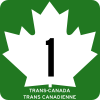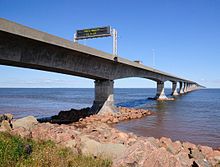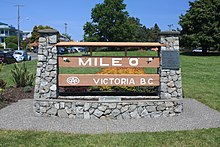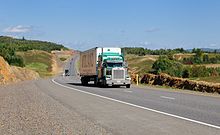Trans-Canada Highway
| Trans-Canada Highway in Canada | |
| Trans-Canada Highway (English) Route Transcanadienne (French) |
|

|
|
| map | |
| Basic data | |
| Operator: | |
| Start of the street: |
Victoria ( 48 ° 25 ′ N , 123 ° 22 ′ W ) |
| End of street: |
St. Johns ( 47 ° 37 ′ N , 52 ° 41 ′ W ) |
| Overall length: | 8030 km |
The Trans-Canada Highway (TCH; French Route Transcanadienne ) is the only federal highway in Canada which, with a few branches, forms a connection system through ten provinces of the country. With over 7000 km, the TCH is both the only continuous transcontinental road link in Canada and the third longest road link in the world. The " Trans-Siberian Road " in Russia and Highway 1 in Australia are longer than the TCH. The Yellowhead Highway forms the northern branch of the TCH in the western provinces. The Trans-Canada Highway opened in 1962, but was not completed until 1970. In the meantime, it has largely been expanded to four lanes and free of intersections.
Route details
West Coast Winnipeg
→ see also: British Columbia Highway 1 , Alberta Highway 1 , Saskatchewan Highway 1 and Manitoba Highway 1
In the four western Canadian provinces the highway runs, mostly separately, in a northern and a southern route.
The northern route begins in Masset on Graham Island and follows the course of British Columbia Highway 16 to the border with Alberta from Prince Rupert on the mainland . Then leads over a length of 534 km, as Alberta Highway 16 across in a west-east direction through Alberta, where he passes Edmonton . In Lloydminster , the northern route changes from Alberta to Saskatchewan and crosses the province as Saskatchewan Highway 16 . It also affects Saskatoon , the largest city in the province. After reaching Manitoba, it passes the province as Manitoba Highway 16 . At Portage la Prairie , it meets Manitoba Highway 1 and thus the southern route of the Trans-Canada Highway in the western provinces. From there, the two routes run together to Winnipeg.
The southern route of the road, known as Highway 1 in the four western provinces, begins in Victoria , British Columbia and runs north along the east coast of Vancouver Island to Nanaimo for the next 99 km . A ferry route (see BC Ferries ) connects the road with West Vancouver . After crossing the Vancouver metropolitan area, she turns east for 170 km to Hope . Then it changes direction north for 186 km. Now it leads in an easterly direction through Kamloops , Banff , Calgary , Regina to Winnipeg .
Winnipeg-Ottawa
The road now runs from Winnipeg for 205 km in an easterly direction to Kenora. The existing branch continues 136 km east to Dryden . A new branch begins on the Rainy River , this leads to Fort Frances. 282 km further east, both branches meet again. Another 65 km - albeit in a south-easterly direction - later you come through Thunder Bay . There the road turns to the northeast and keeps this direction for 115 km, where it divides again at Nipigon .
Northern Route (Highway 11)
The northern route ( Highway 11 ) and runs over 614 km through northern Ontario to Cochrane. Then the road turns again to the southeast until it reaches the town of New Liskeard, then south to North Bay .
There it meets Highway 17, as the southern route from Nipigon to North Bay is called.
General
Most of Ontario has a general speed limit of 90 km / h on the Trans-Canada Highway, 80 km / h on the Central Ontario route and 100 km / h on the freeways .
Ottawa-Moncton
From Ottawa , the TCH runs 206 km east to Montréal . It then follows Autoroute 25 southwards, crosses the St. Lawrence River and continues for 257 km as Autoroute 20 in a north-easterly direction to Lévis .
Moncton-North Sydney
From Moncton, the road branches off for 54 km to the southeast. This is in Atlac on the border of the provinces of New Brunswick and Nova Scotia . From here the main route continues as Newbrunswick Highway 2, largely parallel to the Saint John River and the capital, Fredericton . A 70 km long side route known as Highway 16 leads to the Confederation Bridge on Cape Jourimain.
Prince Edward Island

After crossing the Northumberland Strait, the Borden-Carleton follows 110 km through southern Prince Edward Island. The road is referred to here as Highway 1. Then it leads to Charlottetown . There, on Wood Islands, begins a 26 km long ferry route operated by Northumberland Ferries Ltd., which crosses the Northumberland Strait to Caribou, Nova Scotia (near Pictou). 19 km south of Caribou, the road meets the “direct” Trans-Canada Highway Route (Highway 104) as Highway 106 in Westerville (near New Glasgow).
Nova Scotia
From the New Brunswick border, the Trans-Canada Highway heads east, where it follows Highway 104. He then meets Highway 102 near Truro, which he follows to Halifax. This 30 km long route is subject to a four-dollar tax (per vehicle).
Port aux Basques-St. John's
From North Sydney there is a 177 km ferry route to Newfoundland . When you arrive at the Port aux Basques canal port , the Trans-Canada Highway takes over the route from Highway 1 for 219 km. This leads northeast through Corner Brook, then runs for 352 km east through Gander and finally ends 334 km further southeast in St. John's .
The “mile zero” concept
There is no official mileage, so there is a first mile at both ends. In St. John's , the Mile One Center entertainment center is located at the beginning or end of the Trans-Canada Highway. A monument with the inscription MILE 0 is located in Victoria .
Web links
- Trans-Canada Highway ( English, French ) In: The Canadian Encyclopedia .
- NFB documentary "The Longest Road" (English)
- CBC Digital Archives - Trans-Canada Highway: Bridging the Distance (English)


